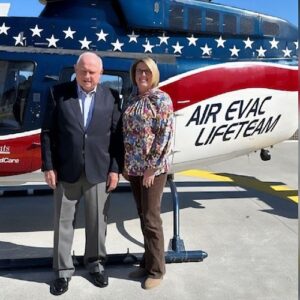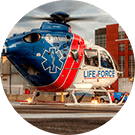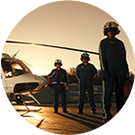Why do you need an Air Ambulance?
Cardiac arrest, a rupturing aneurism, anaphylactic shock, heavy equipment accident – the reasons people need emergency medical care are many. For the most serious, and when time is one of the factors determining positive outcomes, air ambulances are often called to the scene. For most people, the arrival of an air ambulance crew is a relief—knowing that they are one step closer to the definitive care they need.
For Teresa, a patient from rural Georgia, AirEvac Lifeteam, an AirMedCare Network provider, made all the difference after she suffered a stroke at home. Because of the quick thinking of local first responders and the availability of the air ambulance, Teresa was able to receive a clot-busting drug, TPA, which resulted in the rapid resolution of her stroke deficits. In the video below, Teresa credits the entire care team for her outstanding outcome, but especially the rapid response of the air ambulance crew that ensured she would arrive at the hospital in time to receive the drug she desperately needed. Watch Teresa’s story.
Even living in more suburban areas, transport of patients for specialty services, like a Cath lab or Trauma services, also can require transfer via air ambulance due to distance or simply traffic concerns. When you might need an air ambulance, and for what reason, can be more difficult to determine. Planning for this possibility, for you and your entire household, doesn’t have to be.
Assess your need for Air Ambulance Care
Like Teresa and thousands of other patients, it’s easy to assume that you or your family will never need air ambulance care. For hundreds of people every day, that assumption is proven to be false. Assessing the probability that you may have emergent medical needs is important and will help you and your family be financially prepared for this critical health intervention.
Start by answering:
- Are you living in a rural area? Those living in communities a significant distance from a hospital have some of the greatest needs for air ambulances in an emergency.
- Are your local EMS providers ALS level providers? ALS, or Advanced Life Support, providers can perform some of the most effective and needed interventions in the field. From intubation to blood products, ALS providers are needed, but in some areas not available, for the most critical of calls. Air ambulance crews can perform critical medical interventions in the field that Basic Life Support crews cannot.
- Do you live near specialty hospitals? Not all hospitals are the same. From stroke to orthopedic and trauma centers – you may need higher levels of care than a small, local hospital or clinic can provide. Many times, these interfacility transportations can be performed by ground crews, but some require more rapid or advanced interventions during transportation.
- How many people live in your home and what are their underlying health conditions? The more people above age 50 in your home or below age 18 increases the likelihood that you will need air ambulance care.* These two age groups account for the bulk of both fixed-wing and rotor air ambulance patients. If your home homelife involves farm labor or other labor, you also run a higher risk of emergency medical care via air ambulance.
Why do you need Air Ambulance Membership with AMCN?
AirMedCare Network (AMCN), the country’s largest air ambulance membership provider, ensures that only when you are treated and transported by our network’s highly qualified emergency medical crews, you pay nothing out of pocket for this life-saving service. Like Teresa and thousands of our providers’ patients know, anything can happen out of the blue. Copays, deductibles, lack of insurance or even denials of coverage can put patients and their families in a precarious financial situation when the emergency is over. Membership ensures that you will not receive a bill for your air ambulance transport when you needed it most and when flown by one of our providers. Learn more about our AMCN providers in your area online at airmedcarenetwork.com.
Frequently Asked Questions:
If an AirMedCare Network Provider does not transport you, you will be responsible for payment. Our membership program only covers transports provided by our affiliates.
There is no limit to the number of transports a member may take in a year. Each transport is handled the same way and must be an emergent or time-sensitive transport as determined by a physician (or other appropriate provider) or first responder unaffiliated with AMCN.
With an AirMedCare Network membership, any person or persons who reside under one (residential) roof are covered. In the event we have a member who lives in a duplex or apartment complex, we designate the primary member’s residence/address— that is considered the “one roof”. Undergraduate college students can be covered under their parent’s membership as well as anyone previously residing in the household who is then moved to a permanent care facility.

The Importance of Air Ambulance Membership in Medical Emergencies
When it comes to medical emergencies, every second counts. Having access to air ambulance services can make a huge difference in a patient’s health outcome.

Understanding the Risks of Extreme Sports
Extreme sports offer an adrenaline rush and a sense of adventure that attracts millions of people. Understanding the risks associated with extreme sports is crucial

Flying with Chronic Illness
Traveling can be stressful, especially when flying. If you have heart disease, diabetes, or arthritis, it can make things even harder. But everyone deserves an




